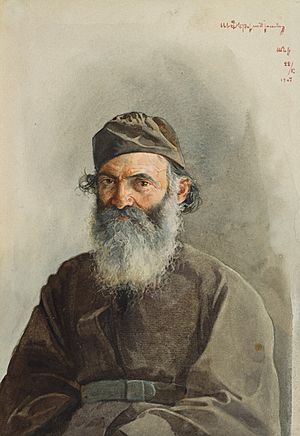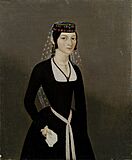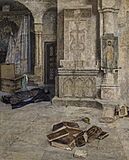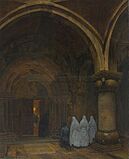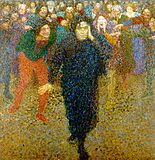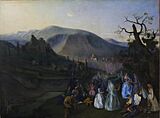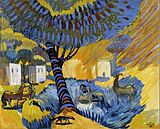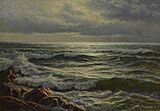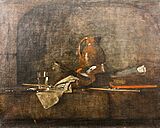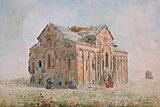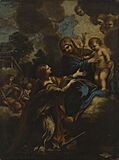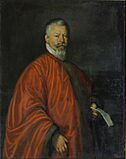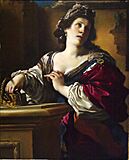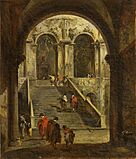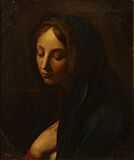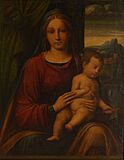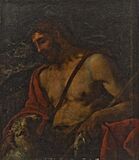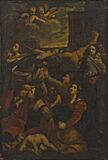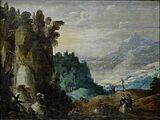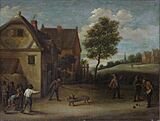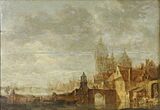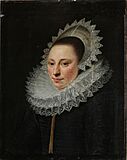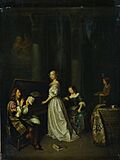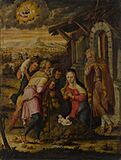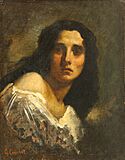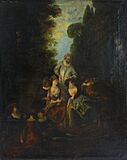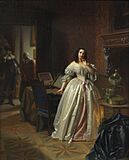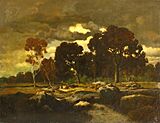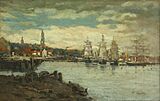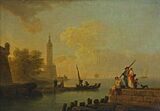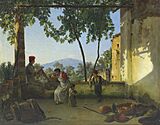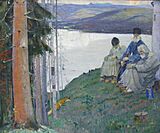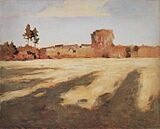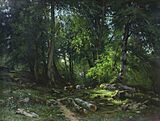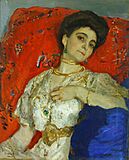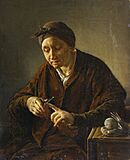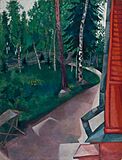National Gallery of Armenia facts for kids
| Հայաստանի ազգային պատկերասրահ | |
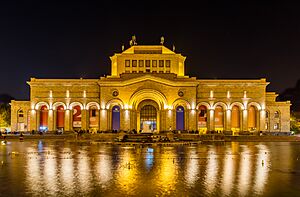
The National Gallery of Armenia in Yerevan
|
|
| Established | 1921 |
|---|---|
| Location | Yerevan, Armenia |
| Type | art gallery |
| Visitors | 80,300 (2016) |
The National Gallery of Armenia (Armenian: Հայաստանի ազգային պատկերասրահ) is the biggest art museum in Armenia. You can find it in Yerevan, right on Republic Square. This makes it a very important building in Armenia's capital city.
The museum has amazing collections of art from Russia and Western Europe. It also holds the largest collection of Armenian art anywhere in the world. In 2016, over 80,000 people visited this wonderful gallery.
Contents
History of the Gallery
The National Gallery of Armenia, often called NGA, was started in 1921. It was created by the government of the Armenian Soviet Socialist Republic. At first, it was part of a larger state museum.
How the Collection Began
When the NGA first opened, it was hard to find art for its collection. There weren't many state-owned or private art collections in Yerevan. The very first artworks came from an exhibition of Armenian painters in August 1921. The museum bought many pieces from this show.
A big help came from the 'Armenian Cultural Center' in Moscow. This center, which used to be the Lazarian Seminary, had a famous art collection. Many Armenian artists also gave their artworks to the NGA. By 1925, the museum had 400 pieces by Armenian, Russian, and European artists. These were shown in six different rooms.
Becoming a Separate Museum
Over the years, the art section of the museum grew and changed. By 1935, it became its own separate Art Museum. In 1947, it was renamed the 'State Picture Gallery of Armenia'. Finally, in 1991, it became the 'National Gallery of Armenia'.
Today, the NGA has about 40,000 artworks. Many of these are always on display in the museum's 56 galleries and halls. People from Armenia and other countries have helped build this amazing collection through their hard work and generous gifts.
What You Can See at the NGA

The NGA has many examples of art from other countries, especially from Western Europe. A lot of these pieces came from the 'Armenian Cultural Center' in Moscow. This collection was moved to Yerevan during the Soviet period.
Ancient and Decorative Arts
The museum's ancient art section includes pieces from old Egypt, Greece, Rome, and Iran. You can see art from different time periods, like the New Kingdom of Egypt or ancient Greek cities.
The Decorative Arts section has beautiful collections of ceramics and porcelain. These come from places like China, Iran, Italy, Japan, Germany, and Austria. There's also a large collection from Russia's Imperial Porcelain Factory from the 1700s and 1800s. You can also find some bronze items from 18th-century China and wooden furniture from 16th- and 17th-century Western Europe.
Museum Facilities
The NGA building also has special studios for restoring and taking care of artworks. There's a library and an archive with lots of information. You can also find a small cafeteria, a souvenir shop, and a hall for showing films and giving talks.
The NGA also shares its art with the world. It lends artworks to exhibitions in other countries. This helps people everywhere appreciate Armenian art.
Armenian Art Collection
Armenian art makes up a huge part of the NGA's collection, with about 700 pieces.
Early Armenian Art
The display of classic Armenian art starts with ancient and Medieval works. You can see copies of old frescoes from Urartu and mosaics from the Garni Temple. There are also Medieval wall paintings and tiny, detailed miniatures.
Some important early pieces include:
- A 7th-century fresco of "Christ Enthroned" from St. Stephanos Church.
- A 10th-century fresco piece of "The Last Judgment" from St. Poghos-Petros.
- A 13th-century fresco showing the Nativity from St. Astvatsatskin.
The museum also has many paintings related to the Armenian Apostolic Church from the 1600s to the 1800s. You can also see silver covers for old books, crosses, and altar curtains from across Asia.
Famous Armenian Painters
The collection of Armenian paintings from the 17th century mostly features art from the Hovnatanian family. Besides works by Hovnatan Hovnatanian, there's a strong collection by Hakob Hovnatanyan. He is known for starting the portrait style in Armenian painting.
The gallery has more than 62 paintings by Ivan Aivazovsky. He was a Russian painter with Armenian roots who created many artworks about Armenian themes.
The biggest part of the Armenian collection shows the work of famous Armenian painters from the 19th and 20th centuries. These include Vardges Sureniants, Stepan Aghajanian, Yeghishe Tadevosyan, Panos Terlemezian, Gevorg Bashinjaghian, Martiros Saryan, Hakob Kojoyan, and Arshak Fetvadjian.
The museum also has many artworks by Armenian artists who lived outside Armenia, known as the diaspora. These include works by Zakar Zakarian, Edgar Chahine, Hovsep Pushman, Jean Carzou, Jean Jansem, Gerardo Oragyan, and Paul Guiragossian. In 2008, a special room was opened just for the works of Hakob Gyurjian.
-
M. Saryan, By the Well. Hot Day, 1908
Western Art Collection
The Western art collection has about 170 pieces. It is divided into four main parts: Italian, Flemish, Dutch, and French art. There are also works by Spanish, German, and other artists.
The museum has many old European masterpieces. These include works by famous artists like Donatello, Tintoretto, Antonio Canova, Joos de Momper, Caspar Netscher, Matthias Stomer, Jan van Goyen, P. Claesz, E. M. Falconet, Carle Vanloo, J. B. Greuze, Joseph Vernet, Robert Hubert, Théodore Rousseau, and Adolphe Monticelli. There are also over 180 European drawings from the 16th and 17th centuries.
Italian Art
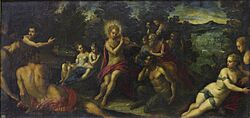
The Italian collection starts with art from the 14th century. A notable piece is "Christmas" by an unknown artist from the circle of Botticelli. "Apollo and Pan" by the famous Tintoretto is a great example of the High Renaissance period.
For portraits from the 17th century, you can see "Portrait of Nikola Kuchi" by Bernardo Strozzi. There are also two portraits by Guercino, who was part of the Bolognese School. An earlier portrait style is shown in a painting by Pontormo.
The museum has a large collection of art about the Bible. This includes "The birth of Jesus and Adoration of the Shepherds" by Jacopo Bassano. Other works are by Leandro Bassano, Luca Giordano, Pietro da Cortona, Sebastiano Ricci, Luca Signorelli, Pompeo Batoni, Bernardino Luini, Paolo Farinati, Giovanni Battista Salvi da Sassoferrato, Alessandro Turchi, and Giacomo Cavedone. There are also many beautiful portraits of the Virgin Mary by artists like Benvenuto Tisi, Sebastiano Conca, and Elisabetta Sirani.
Landscape paintings from the 18th century are shown through works by Francesco Guardi, Francesco Zuccarelli, and Gisolphi. The collection also includes drawings by Giovanni Domenico Tiepolo, Giovanni Paolo Panini, Federico Zuccari, Jacopo da Empoli, Luca Cambiasi, and Stefano della Bella.
-
P. Cortona, St. Mary, little Jesus and st. Katharina
-
B. Strozzi, Portrait of Nikola Kuchi
-
J. Bassano, The birth of Jesus and adoration of the shepherds
-
Guercino, Cleopatra
-
F. Guardi, Yard
-
S. Conca, Godmother
-
L. Signorelli, Children's massacre
Flemish and Dutch Art
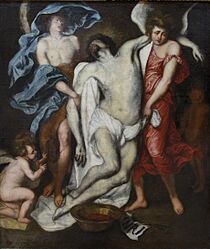
In 1982, the gallery had about 30 Flemish artworks and 60 Dutch artworks on display. Most of these are from the 17th century.
The Flemish art school has important pieces like "Procession of Silenus" by Peter Paul Rubens and "Descent from the Cross" by Anthony van Dyck. There are also great still-life paintings by Verbruggen and Jan Fyt, and "Mountain landscape" by Joos de Momper. You can see portraits, including a woman's portrait by Pieter Pourbus. Two works by David Teniers the Younger show everyday life. "Faun visiting peasants" by Jan Cossiers is an example of realism.
The Dutch collection includes works by famous artists from the Dutch Golden Age painting. This section has "Singing lesson" by Caspar Netscher, "Company at the Table" by Pieter Codde, and "Holiday" by Joost Cornelisz Droochsloot. You can also see paintings showing tavern scenes. "War and Peace" by Hendrick Goltzius is also here. "Birth of Christ" by Joos van Cleve is based on a Bible story.
Paintings by several landscape artists are in the gallery. These include "View of Dordrecht" by Jan van Goyen, "Landscape with a Broken Tree" by Allaert van Everdingen, and a sea landscape by Ludolf Bakhuizen. The gallery also has "Italianate landscapes" by Nicolaes Pieterszoon Berchem, Cornelis van Poelenburgh, Karel Dujardin, and Frederik de Moucheron. Dutch still life artists like Pieter Claesz, Jan Weenix, and Abraham van Beijeren are also featured. Dutch portraits include "The Money-changer" by Stom and a woman's portrait by Caspar Netscher.
The Dutch collection also has military art, such as "Poles in the battle against the Swedes" by Philips Wouwerman and "Battle" by Esaias van de Velde. The collection includes drawings by Adriaen van Ostade, Jan Lievens, Jan van der Heyden, Maerten van Heemskerck, Godfried Schalcken, Abraham van Diepenbeeck, Adriaen van de Velde, and Jan Dirksz Both.
-
D. Teniers, Playing skittles
-
J. van Goyen, Dordrecht
-
C. Netscher, Singing lesson
-
M. Stom, Exchange
-
J. van Cleve, The birth of Christ
French Art
The French painting collection is the largest among the Western art sections. It starts with works from the 17th century. These include "Rinaldo and Armida" by Jean-Honoré Fragonard and "Head of a Young Woman" by Jean-Baptiste Greuze. You can also see works by Jean-Marc Nattier, Nicolas de Largillière, François-Hubert Drouais, Charles-André van Loo, and Jacques Courtois.
Recently, the gallery received "Young woman with a flower" by François Boucher, a famous artist of the rococo style. Other rococo works include "The Italian actors" by Nicolas Lancret and "Sleeping child with angels" by François Lemoyne. Portraits by Élisabeth Louise Vigée Le Brun show the styles of sentimentalism and classicism.
The development of landscape painting in France can be seen starting in the 17th century with the work of Gaspard Dughet. From the 18th century, there are three pieces by Hubert Robert and three by Claude-Joseph Vernet.
The gallery has works by artists from the Barbizon school. These artists greatly influenced realistic art in France in the 19th century. You can see "Dusk in a forest" by Théodore Rousseau, two paintings by Narcisse Virgilio Díaz, and a seascape by Félix Ziem. The gallery also shows "Portrait of a girl" by Gustave Courbet, a leader of the realism movement. Other French artists from this period include Horace Vernet, Alexandre-Gabriel Decamps, and Théodore Gudin.
Works by Eugène Boudin, Louis Anquetin, Bernard Buffet, and Adolphe Monticelli give a quick look at how French art developed later. The collection also includes drawings by Jean-Antoine Watteau, Jean-Baptiste Greuze, Jacques Bellange, Jules Pascin, and Auguste Rodin. There are sculptures by Antonio Canova and Étienne Maurice Falconet.
-
G. Courbet, Portrait of a girl
-
N. Lancret, The Italian actors
-
E. Delacroix, The guest
-
T. Rousseau, Dusk in a forest
-
E. Boudin, Sea port
-
J. Vernet, Sea view
-
H. Robert, Ancient temple
Spanish, German, and Other Artists
The Spanish art section has several works. One important painting is The Descent from the Cross by Luis de Morales, a key artist of Spanish mannerism. The collection also includes an etching called "Bulls" by Francisco Goya, a great master of the romantic period. You can also see "The Moment of Lecture" by Marià Fortuny, who was a leader in romantic orientalism. Recently, the gallery received four drawings by Salvador Dalí.
German art is shown through landscape painters like Jacob Philipp Hackert and Johann Heinrich Roos. The collection also has nine drawings by the famous German painter Albrecht Dürer. There's an engraving called "Christ presented to the people" by Sebald Beham, and a drawing by Franz Stuck.
Besides Spanish and German artists, the gallery has paintings by Swiss artists Alexandre Calame and Louis Léopold Robert. There are also works by Daniel Chodowiecki, January Suchodolski, Ion Andreescu, and Ștefan Dimitrescu.
Russian Art Collection
Russian art is also a big part of the NGA's collection, with about 230 artworks.
18th and 19th Century Russian Art
Russian art from the mid-18th century onwards is on display. The gallery has portraits and sculptures from the late 1700s and early 1800s. These include works by Ivan Argunov, Dmytro Levytsky, Fyodor Rokotov, Vladimir Borovikovsky, Ivan Martos, and Fedot Shubin.
Russian landscape art from the 18th century is shown through paintings by Fyodor Matveyev and Mikhail Ivanov.
Russian painting from the first half of the 19th century includes works by Orest Kiprensky, four paintings by Vasily Tropinin, and three by Sylvester Shchedrin. There are also works by Karl Bryullov and Pyotr Basin. Artworks by Henryk Siemiradzki, Sergey Zaryanko, Ivan Khrutsky, and Vasily Serebryakov show the second half of the 19th century.
Late 19th and Early 20th Century Russian Art
The period around the late 1800s and early 1900s is shown with works by Alexandre Benois. Artists from the symbolism movement, like Boris Anisfeld and Victor Borisov-Musatov, are also featured. The collection also includes Russian avant-garde art.
This period's masterpieces include "Summer residence" by Marc Chagall and two works by Wassily Kandinsky. There are also five works by Ivan Shishkin and ten by Isaac Levitan. You can see many works by Vasily Surikov, Ilya Repin, Valentin Serov, Arkhip Kuindzhi, Vasily Vereshchagin, Konstantin Makovsky, Vladimir Makovsky, Vasily Polenov, Mikhail Vrubel, Mikhail Nesterov, and Kuzma Petrov-Vodkin. The museum has the most complete collection of paintings by Ivan Aivazovsky, with about 60 artworks.
-
M. Nesterov, Three old men
-
I. Levitan, Autumn. Sunny Day
-
I. Shishkin, In the forest
-
V. Serov, Portrait of M. N. Akimova
-
I. Repin, Portrait of Tevashova
-
K. Bryullov, Portrait of M. A. Bek
-
M. Chagal, Summer residence
Directors of the Gallery
Here are the people who have led the National Gallery of Armenia over the years:
- Marina Hakobyan (since 2020)
- Arman Tsaturyan (2015-2020)
- Pharaon Mirzoyan (2002–2015)
- Shahen Khachatryan (1991–2002)
- Alexandr Ter-Gabrielyan (1987–1990)
- Eduard Isabekyan (1967–1987)
- Armen Chilingaryan (1962–1967)
- Ruben Parsamyan (1952–1962)
- Ruben Drampyan (1925–1951)
See also
 In Spanish: Galería nacional de Armenia para niños
In Spanish: Galería nacional de Armenia para niños
- List of national galleries
- Lydia Durnovo, art historian and restorer


